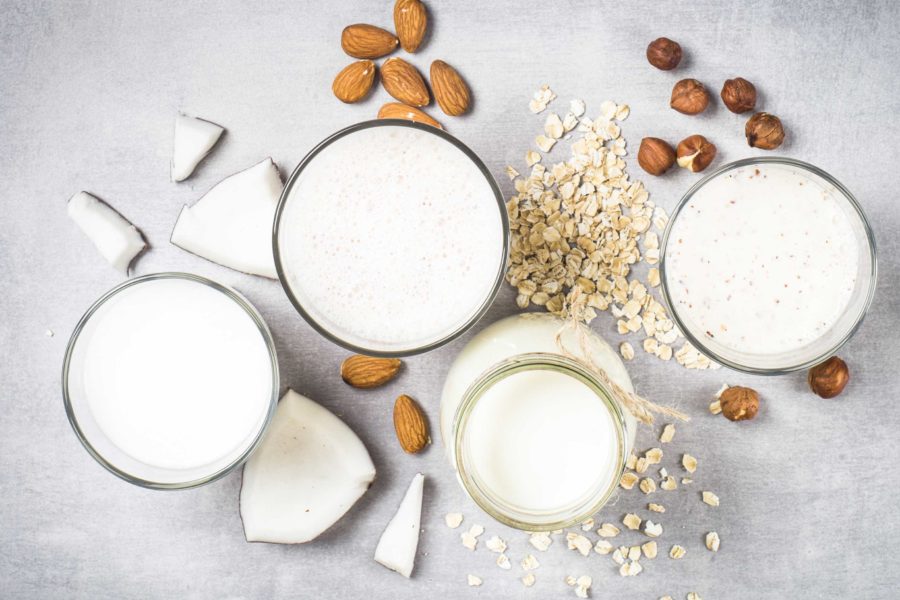Do you remember the days when a milkman came and made his daily delivery at your doorstep, fresh milk straight from the cows at the local farm? Probably not, but your parents may. While there are services that still or have started to deliver (thank you Thatcher Farm in Milton, Crescent Ridge in Sharon and Shaw Farm in Dracut, among others), in general those days are long gone.
In fact, the days of cow’s milk as the only milk are long gone. In 2019, milk is trendy, and milk is niche. Milk alternatives are in. From raw milk to almond to oat to soy to hemp, you can trade in cow’s milk for whatever suits your dietary restrictions — required or self-imposed.
So, whether you’re lactose intolerant, don’t enjoy the inflammatory effects dairy has on you, or don’t trust the amount of hormones injected into cows, we’ve got the lowdown on nine types of “milk.”
Type: The Original, Cow’s Milk
Whole milk is derived from cows, without any of its natural fats removed.
Pros: Cow’s milk is a significant source of protein, calcium and vitamins, especially biotin (B7), riboflavin (B2) and cobalamin (B12).
Cons: There are some studies disputing the effectiveness of cow’s milk improving bone integrity in children.
Also, whole milk is high in saturated fats and calories. And, some farmers use growth hormones on cows, which can be ingested through their milk by humans and potentially have adverse effects on our health.
Drinkability: Whole milk derived from cows has a thick and heavy consistency and a rich taste, with a very subtle sweetness.
Type: Cow’s Milk, Served Raw
Also known as unpasteurized milk, raw milk is natural and unprocessed straight from the mammal. Pasteurization involves heating milk to kill bacteria, yeasts and molds.
Pros: Some raw milk advocates believe that milk in its natural state contains more amino acids, antimicrobials, vitamins, minerals and fatty acids than pasteurized milk. Boston restaurateur Kristin Canty is a big advocate for the raw milk movement.
Cons: Agencies like the FDA and the CDC warn consumers against drinking raw milk because it can carry dangerous bacteria such as salmonella, E. coli, listeria and other food-borne illnesses.
Drinkability: We thought we’d go to an expert on this one. “I’m an advocate for flavor. I think milk has a superior flavor when it’s not pasteurized,” said Dan Barber, the chef and co-owner of Manhattan restaurant Blue Hill and an Obama-era member of the President’s Council on Physical Fitness, Sports and Nutrition, in an article in The New Yorker. He also says the flavor of raw milk is largely dependent on what the cow eats.
Type: Soy Milk, The Familiar Alternative
Soy milk is a plant-based milk alternative made from soaking and grinding soybeans, boiling the mixture and filtering it through water.
Pros: Soy milk contains no lactose for those who are intolerant to it, and because it’s derived from a plant, it is cholesterol-free and low in saturated fat. It’s a good source of protein, vitamin A, vitamin B-12 and potassium.
Cons: Soy milk has to be fortified with calcium and vitamin D for consumers to get the same health benefits as milk, but most, if not all, soy milks on the market are fortified. Too much soy may have negative effects on health, especially for people with thyroid conditions.
Also, soy is a common allergen.
Drinkability: No real flavor to the unsweetened variety, although there is a slightly chalky finish. Thick enough to use as a coffee creamer or on cereal.
Type: Rice Milk, Our Minimalist
This type of milk alternative is simply made from rice and water, and it frequently contains additives to improve its shelf life and consistency.
Pros: Rice milk usually tastes sweeter than other alternative milks and can be a good option for those with allergies or food intolerances to soy and lactose.
Cons: Rice milk is not a natural source of calcium and vitamin D — but can be fortified with both — and, in fact, doesn’t have many nutrients at all. It is also high in carbohydrates.
Drinkability: Innately sweet — even the unsweetened version. Rice milk is watery and wouldn’t be a strong stand-in for cow’s milk, but is just fine when not making a comparison.
Type: Almond Milk, The Popular Choice
This type of milk is made from ground almonds and filtered water.
Pros: Almond milk is free of saturated fats and low in calories, as long as it is unsweetened.
Cons: Even though almonds are a natural source of protein, its milk is not, so don’t be fooled.
Like many of its alternative counterparts, it also has to be fortified with calcium and vitamin D in order to be as beneficial as regular milk.
Drinkability: Subtle, nutty flavor with a hint of sweetness and a light consistency. It’s suitable to add to coffee (although it doesn’t blend very well) and have with cereal, but it is not an ideal substitute for recipes that call for cream.
Type: Smooth and Silky Cashew Milk
Similar to almond milk, cashew milk is a lactose-free drink made from ground cashews and filtered water.
Pros: Cashew milk is naturally thicker and sweeter than almond milk, and it is rich in healthy fats. It also contains potassium, magnesium and vitamin K, which is known to decrease the risk of blood clots. It may also boost your body’s immunity, and it’s fantastic for your skin.
Cons: Cashew milk is not a natural source of calcium and vitamin D. Store brands usually, but not always, fortify formulas with these nutrients.
Drinkability: Like almond milk, cashew milk has a subtle, nutty flavor, and we think it is more flavorful than rice milk but not as sweet. Texturally, it is thick and smooth.
Type: The Nutty Cousin, Coconut Milk
Coconut milk is made from filtered water and coconut cream, which is derived from grated mature coconut flesh.
Pros: Coconut milk has a creamier consistency than other dairy alternatives, making it ideal for making ice cream or thick soups. It does contain more fat than other types of alternative milk, but they are considered healthy fats that the body needs.
Cons: Coconut milk is not a natural source of calcium, vitamin A or vitamin D and has to be fortified with these ingredients in order to be as beneficial as regular milk.
Drinkability: If you don’t like shredded coconut, macaroons and other coconut products, you definitely won’t like coconut milk. The fruit’s strong flavor pervades, so even if you’re eating a dish of vegan mint chip ice cream made with coconut milk, it’ll still taste pretty coco-nutty.
Hemp Milk, The Hippie Drink
Hemp milk is made by blending water with the seeds of the hemp plant, cannabis sativa. Although this plant is also used to produce marijuana, hemp milk contains unnoticeable trace amounts of the psychoactive ingredient THC.
But, if you are looking to wind down with a glass of hemp milk without getting high, dropping a couple drops of CBD oil in it wouldn’t hurt.
Pros: It has fewer carbs than regular milk and more protein, iron and omega fatty acids compared to almond milk. It is free of soy, lactose and gluten.
Cons: Although hemp milk is a complete protein, it contains less protein than whole milk and has to be fortified with calcium and vitamin D. Plus, it has a higher fat content than cow’s milk.
Drinkability: We liked the hemp milk the least of all the alternatives we tried. It is very thin, and tastes a bit like soapy water.
Oat Milk, The Newcomer
This milk alternative is made by soaking and blending steel-cut or rolled oats with water and then straining it through cheesecloth to isolate the milk from the oats.
Pros: Oat milk is free of lactose, soy, gluten and nuts, making it the ideal alternative for people with multiple food intolerances. It’s also a natural source of nutrients and vitamins such as potassium, calcium, riboflavin and vitamins D and A.
Cons: Oat milk has more calories and carbs than almond, soy, or cow’s milk and is not a good source of protein.
Drinkability: Oat milk was our favorite for standalone flavor, and is closest to cow’s milk in consistency. Naturally, it is great over breakfast cereal.



 7 min read
7 min read


